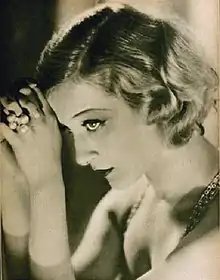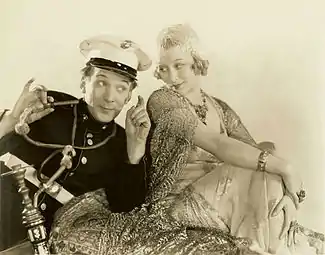Greta Nissen | |
|---|---|
.jpg.webp) Nissen in 1925 | |
| Born | Grethe Rüzt-Nissen January 30, 1906 |
| Died | May 15, 1988 (aged 82) Montecito, California, U.S. |
| Years active | 1923-1937 |
| Spouses | |
| Children | 1 |
Greta Nissen (born Grethe Rüzt-Nissen; 30 January 1906 – 15 May 1988)[1] was a Norwegian-American film and stage actress.
Stage and screen actress
Born Grethe Rüzt-Nissen in Kristiania (now Oslo), Norway, Nissen was originally a dancer. While still a student at the company's school in Copenhagen, she danced with the Royal Danish Ballet,[2] debuted as a solo ballerina on the National Theatre in 1922. She toured in Norway and appeared in several Danish films.
Nissen made her Broadway debut as a ballerina in 1924. She had studied ballet with Michel Fokine. In early 1924, she came as a member of a Danish ballet troupe to New York, where she was soon hired to do a larger dance number for George S. Kaufman in the musical Beggar on Horseback.[3] She was discovered by film producer Jesse L. Lasky of Paramount Pictures, and would appear in more than twenty films.
She appeared in The Wanderer (1925, director Raoul Walsh). Among her other films were Lost: A Wife, The King on Main Street, The Love Thief, Ambassador Bill, The Lucky Lady, and Honours Easy.
.jpg.webp)
Nissen was cast as Helen, the female lead in Hell's Angels, originally conceived as a silent film. Principal photography began on 31 October 1927, with an interior shot at the Metropolitan Studio in Hollywood.[4]
Midway through production, the advent of sound in motion pictures came with the arrival of The Jazz Singer.
Director Howard Hughes incorporated the new technology into the half-finished film, but Nissen became a casualty of the new sound age, due to her pronounced Norwegian accent.[5] He paid her for her work and cooperation, and replaced her, because her accent would make her role as a British aristocrat ludicrous.[6]
In 1932, she played in The Silent Witness with Weldon Heyburn, who became her first husband. They married on 30 March 1932,[7] in Tijuana, Mexico.[8] On 19 October 1935, Nissen went to court to have the marriage annulled, "charging their marriage ... was illegal and violated legal witness and residence requirements."[9] The annulment was granted on 30 April 1936.[10]
In 1933, she moved to England. Her film career ended in the mid-1930s after she had appeared in a few British films. In 1937, she retired from movie acting altogether.[11]
Critical acclaim

A 1925 New York Times review[12] of the silent film A Norwegian Actress described Nissen as follows:
She was graceful in her movements and expressions, with a constantly changing gaze. The actress was attractive rather than beautiful. Her chin and nose were both somewhat pronounced. Greta's personality was delightful and she never showed an awareness to the audience that she was conscious of being on camera. Her skin was fair and she possessed blonde hair. At different times her coiffure had a somewhat "wild" appearance.
The reviewer believed her hair was more effective when it was brushed down rather than when it was concealed by a small hat. As for her eyes, there was a close affinity in their appearance to those of Sarah Bernhardt. Mordaunt Hall commented on her acting, saying, "Miss Nissen gives a sincere and earnest portrayal, always obtaining excellent results with an originality rarely beheld on the screen".[13]
Later years and death
On 1 June 1941, she married industrialist Stuart D. Eckert (1907–1993), and withdrew from public life.[14] Nissen died at age 82 at her home in Montecito, California of Parkinson's disease on 15 May 1988.[15]
Her husband said she still received fan letters. She had one son, Tor Bruce Nissen Eckert, who, in 2005, donated his large collection of Greta Nissen Memorabilia to the Norwegian Emigrant Museum (Norsk Utvandrermuseum) which is located in Ottestad, Hedmark, Norway.[16][17]
Gallery
 Promotional photo of El Brendel and Greta Nissen for the 1931 comedy film Women of All Nations
Promotional photo of El Brendel and Greta Nissen for the 1931 comedy film Women of All Nations Promotional photo of Nissen, with Victor McLaglen and Edmund Lowe, for the 1931 comedy film Women of All Nations
Promotional photo of Nissen, with Victor McLaglen and Edmund Lowe, for the 1931 comedy film Women of All Nations Argentinian magazine cover, 1931
Argentinian magazine cover, 1931 Argentinian magazine photoshoot, 1933
Argentinian magazine photoshoot, 1933
Filmography
- Daarskab, dyd og driverter (1923) - Grethe
- Lille Lise let-paa-taa (1923) - Lise
- Lost: A Wife (1925) - Charlotte Randolph
- In the Name of Love (1925) - Marie Dufrayne
- The Wanderer (1925) - Tisha
- The King on Main Street (1925) - Thérèse Manix
- The Lucky Lady (1926) - Antoinette
- The Love Thief (1926) - Princess Flavia Eugenia Marie
- Ebberöds bank (1926)
- The Lady of the Harem (1926) - Pervaneh
- The Popular Sin (1926) - La Belle Toulaise
- Blonde or Brunette (1927) - Fanny
- Blind Alleys (1927) - Maria d'Alvarez Kirby
- Horse Shoes (1927)
- Fazil (1928) - Fabienne
- The Butter and Egg Man (1928) - Mary Martin
- Women of All Nations (1931) - Elsa
- Transatlantic (1931) - Sigrid Carline
- Ambassador Bill (1931) - Countess Ilka
- Good Sport (1931) - Peggy Bums
- The Silent Witness (1932) - Nora Selmer
- Rackety Rax (1932) - Voine
- The Unwritten Law (1932) - Fifi La Rue
- The Circus Queen Murder (1933) - Josie La Tour
- Melody Cruise (1933) - Elsa Von Rader
- Best of Enemies (1933) - The Blonde
- Life in the Raw (1933) - Belle
- Red Wagon (1933) - Zara
- On Secret Service (1933) - Marchesa Marcella Galdi
- Hired Wife (1934) - Vivian Mathews
- The Luck of a Sailor (1934) - Queen Helena
- Honours Easy (1935) - Ursula Barton
- Cafe Colette (1937) - Vanda Muroff (final film role)
References
- ↑ Eugene Michael Vazzana (May 1995). Silent film necrology: births and deaths of over 9000 performers, directors, producers, and other filmmakers of the silent era, through 1993. McFarland. p. 245. ISBN 9780786401321. Retrieved 31 July 2010.
- ↑ Pat Ryan. "A Dancer Must Be Perfect All over": Greta Nissen on Stage and Screen", in Dance Chronicle, vol. 12, no, 3, 1989, pg. 285
- ↑ Hans J. Wollstein (1994). Strangers in Hollywood: the history of Scandinavian actors in American films from 1910 to World War II. Scarecrow Press. p. 272. ISBN 978-0-8108-2938-1. Retrieved 30 July 2010.
- ↑ Barlett, Donald L. and James B. Steele. Empire: The Life, Legend and Madness of Howard Hughes. New York: W.W. Norton & Company, 1979; ISBN 0-393-07513-3, republished in 2004 as Howard Hughes: His Life and Madness, pg. 63.
- ↑ Lynn Kear; James King (June 2009). Evelyn Brent: The Life and Films of Hollywood's Lady Crook. McFarland. p. 151. ISBN 978-0-7864-4363-5. Retrieved 31 July 2010.
- ↑ Stenn, David (1993). Bombshell: The Life and Death of Jean Harlow. New York: Bentam Doubleday Dell Publishing. pp. 34–38. ISBN 0-385-42157-5.
- ↑ "Greta Nisson to Become Bride of Hollywood Actor". The Klamath News. Oregon, Klamath Falls. The Klamath News. 30 March 1932. p. 1. Retrieved 5 February 2016 – via Newspapers.com.

- ↑ "Greta Nissen and Weldon Heyburn Are Honeymooning". The Lincoln Star. Nebraska, Lincoln. The Lincoln Star. 31 March 1932. p. 9. Retrieved 5 February 2016 – via Newspapers.com.

- ↑ "Greta Nissen Sues To Annul Marriage". Oakland Tribune. California, Oakland. Oakland Tribune. 20 October 1935. p. 5. Retrieved 5 February 2016 – via Newspapers.com.

- ↑ "Marriage Ends". Texas, Lubbock. Morning Avalanche. 30 April 1936. p. 2. Retrieved 5 February 2016 – via Newspaperarchive.com.
- ↑ Grethe Rüzt-Nissen, Danser Skuespiller (Hans-Christian Arent. Norsk biografisk leksikon)
- ↑ Hall, Mordaunt (22 June 1925). "The Screen, A Norwegian Actress". The New York Times. p. 10.
- ↑ Hall, Mordaunt (28 June 1925). "Exceptional Performance Given By Talented Young Norwegian Actress". The New York Times. p. X2.
- ↑ "A Dancer Must Be Perfect All over": Greta Nissen on Stage and Screen", Pat M. Ryan, in Dance Chronicle, vol. 12, no, 3, 1989, p. 285
- ↑ Hans J. Wollstein (1994). Strangers in Hollywood: the history of Scandinavian actors in American films from 1910 to World War II. Scarecrow Press. p. 282. ISBN 978-0-8108-2938-1. Retrieved 30 July 2010.
- ↑ "Greta Nissen Dies; Her Beauty Graced Many Silent Movies". The Post-Standard. 16 July 1988. p. A8.
- ↑ Cathrine Arnesen. "Norsk Utvandrermuseum". Store norske leksikon. Retrieved 5 March 2016.